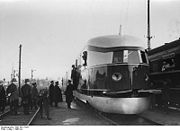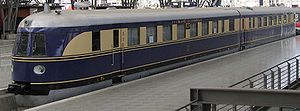
DRG Class SVT 877
Encyclopedia

German language
German is a West Germanic language, related to and classified alongside English and Dutch. With an estimated 90 – 98 million native speakers, German is one of the world's major languages and is the most widely-spoken first language in the European Union....
Fliegender Hamburger – was Germany
Germany
Germany , officially the Federal Republic of Germany , is a federal parliamentary republic in Europe. The country consists of 16 states while the capital and largest city is Berlin. Germany covers an area of 357,021 km2 and has a largely temperate seasonal climate...
's first fast diesel train
Diesel multiple unit
A diesel multiple unit or DMU is a multiple unit train consisting of multiple carriages powered by one or more on-board diesel engines. They may also be referred to as a railcar or railmotor, depending on country.-Design:...
, and is credited with establishing the fastest regular railway connection in the world in its time. Correctly named the Baureihe SVT 877 (later DB
Deutsche Bundesbahn
The Deutsche Bundesbahn or DB was formed as the state railway of the newly established Federal Republic of Germany on September 7, 1949 as a successor of the Deutsche Reichsbahn-Gesellschaft '...
Baureihe VT 04 000 a/b), the diesel-electric powered train was used to carry passengers on the Berlin–Hamburg line. It entered service in 1933.
Development and technical data
The Hamburg Flyer, a train consisting of two cars – each having a driver's cab and passenger cabin – was ordered by the Deutsche Reichsbahn-GesellschaftDeutsche Reichsbahn-Gesellschaft
The Deutsche Reichsbahn – was the name of the German national railway created from the railways of the individual states of the German Empire following the end of World War I....
in 1932 from Waggon- and Maschinenbau AG Görlitz
Görlitz
Görlitz is a town in Germany. It is the easternmost town in the country, located on the Lusatian Neisse River in the Bundesland of Saxony. It is opposite the Polish town of Zgorzelec, which was a part of Görlitz until 1945. Historically, Görlitz was in the region of Upper Lusatia...
(WUMAG). The train was delivered in 1932 and put into service in 1933.
The train was streamlined
Streamliner
A streamliner is a vehicle incorporating streamlining in a shape providing reduced air resistance. The term is applied to high-speed railway trainsets of the 1930s to 1950s, and to their successor "bullet trains". Less commonly, the term is applied to fully faired recumbent bicycles...
after wind tunnel
Wind tunnel
A wind tunnel is a research tool used in aerodynamic research to study the effects of air moving past solid objects.-Theory of operation:Wind tunnels were first proposed as a means of studying vehicles in free flight...
experiments, a sort of research which was pioneered by the developers of the high-speed interurban
Interurban
An interurban, also called a radial railway in parts of Canada, is a type of electric passenger railroad; in short a hybrid between tram and train. Interurbans enjoyed widespread popularity in the first three decades of the twentieth century in North America. Until the early 1920s, most roads were...
railcar Bullet
Bullet (interurban)
The Bullet was a high-speed interurban railcar produced by J. G. Brill and Company in Philadelphia for the Philadelphia and Western Railroad in 1931, and then the Fonda, Johnstown and Gloversville Railroad in 1932. Few were sold because of the Great Depression and the public transport decline in...
a couple of years before. The Fliegender Hamburger design was very similar to the Bullet's. Its lightweight, articulated construction and Jakobs bogies were also known on the US interurban scene. However, the Fliegender Hamburger had diesel-electric propulsion. Each of the two coaches had a 12-cylinder Maybach
Maybach
Maybach-Motorenbau GmbH is a German luxury car manufacturer. It was founded in 1909 by Wilhelm Maybach and his son. The company was originally a subsidiary of Luftschiffbau Zeppelin GmbH and was itself known as Luftfahrzeug-Motorenbau GmbH until 1912.Today, the ultra-luxury car brand is owned by...
diesel engine with a direct current
Direct current
Direct current is the unidirectional flow of electric charge. Direct current is produced by such sources as batteries, thermocouples, solar cells, and commutator-type electric machines of the dynamo type. Direct current may flow in a conductor such as a wire, but can also flow through...
generator directly coupled to it, which drove a Tatzlager-traction motor. The two engines developed a combined power of 604 kW
Kw
kw or KW may refer to:* Kuwait, ISO 3166-1 country code** .kw, the country code top level domain for Kuwait* Kilowatt* Self-ionization of water Kw* Cornish language's ISO 639 code* Kitchener–Waterloo, Ontario, Canada...
.
The train had a pneumatic brake developed by Knorr and an electromagnetic rail brake
Electromagnetic brake
An eddy current brake, like a conventional friction brake, is responsible for slowing an object, such as a train or a roller coaster. However, unlike electro-mechanical brakes, which apply mechanical pressure on two separate objects, eddy current brakes slow an object by creating eddy currents...
. At 160 kilometres per hour (99.4 mph), it needed 800 metres (2,624.7 ft) to come to a halt.

DRG Class SVT 137
The DRG Class SVT 137 was a class of streamlined diesel train sets of the Deutsche Reichsbahn-Gesellschaft and later of the Deutsche Bundesbahn and the Deutsche Reichsbahn...
, which were called Hamburg, Leipzig, Köln and Berlin.
As a sign of its exclusivity, the Hamburg Flyer was painted cream and violet – like the coaches of the Rheingold Express
Rheingold Express
The legendary Rheingold was a famous train riding between Hoek van Holland near Rotterdam and Basel, Switzerland, a distance of . It ran along the Rhine River via Arnhem, Netherlands and Cologne, Germany using special luxury coaches...
train.
The success of this design led Henschel to develop the streamlined and steam-powered Henschel-Wegmann Train
Henschel-Wegmann Train
The Henschel-Wegmann Train was a unique passenger express train operated by the Deutsche Reichsbahn in Germany, which ran non-stop express services between Berlin and Dresden from June 1936 to August 1939...
in 1935 which boasted comparable performances on the routes between Berlin and Dresden
Dresden
Dresden is the capital city of the Free State of Saxony in Germany. It is situated in a valley on the River Elbe, near the Czech border. The Dresden conurbation is part of the Saxon Triangle metropolitan area....
.
Employment by the Deutsche Reichsbahn
From 15 May 1933, the train ran regularly between Berlin (Lehrter Bahnhof) and Hamburg's central stationHamburg Hauptbahnhof
is the Hauptbahnhof for the German city of Hamburg. It was opened in 1906 to replace 4 terminal stations. Hamburg Hauptbahnhof is operated by DB Station&Service...
. The train travelled the 286 kilometres (177.7 mi) in 138 minutes – an astonishing average speed of 124 kilometres per hour (77.1 mph). This performance was only equalled 64 years later, as the Deutsche Bahn began to use ICE
InterCityExpress
The Intercity-Express or ICE is a system of high-speed trains predominantly running in Germany and neighbouring countries. It is the highest service category offered by DB Fernverkehr and is the flagship of Deutsche Bahn...
trains between the two cities in May 1997.
During World War II
World War II
World War II, or the Second World War , was a global conflict lasting from 1939 to 1945, involving most of the world's nations—including all of the great powers—eventually forming two opposing military alliances: the Allies and the Axis...
, the diesel trains saw no service. After 1945 they were confiscated by the French occupation army and were used in France until 1949. The Deutsche Bahn put them into service again up to 1957, but with a red painted hull and a new type number (VT 04 000). Only the driver's cab, the engine compartment and the saloon are preserved, the other parts were scrapped; the existing remains are preserved in the Transportation Museum in Nuremberg
Nuremberg
Nuremberg[p] is a city in the German state of Bavaria, in the administrative region of Middle Franconia. Situated on the Pegnitz river and the Rhine–Main–Danube Canal, it is located about north of Munich and is Franconia's largest city. The population is 505,664...
. A set of the Series SVT 137, which had previously been refitted for DDR government use, is preserved complete at Leipzig
Leipzig
Leipzig Leipzig has always been a trade city, situated during the time of the Holy Roman Empire at the intersection of the Via Regia and Via Imperii, two important trade routes. At one time, Leipzig was one of the major European centres of learning and culture in fields such as music and publishing...
station.
External links
- On display at the Leipzig main station
- "Test Train At 100-mile clip" Popular Science, March 1933, article at bottom of page 21

